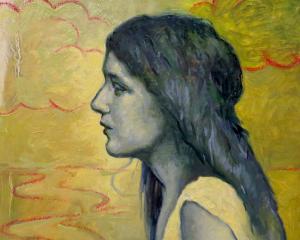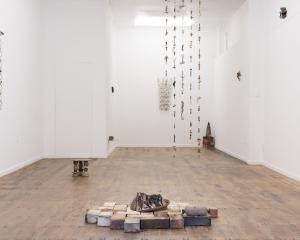
(Brett McDowell Gallery)
Jane Dodd’s jewellery exhibition at Brett McDowell Gallery includes several pieces doubling up their display with the artist’s current show at Otago Museum.
In order to accommodate this situation of being in two places at once, several of the artist’s humorous pieces are represented by photographs, all displayed within attractive vintage frames. These images serve as both an extension of the McDowell exhibition and as a wry advertisement for the museum show.
The pieces presented "in person" at the Brett McDowell Gallery more than make up for any feelings of lack which may be felt from this second-hand presence. Over 30 pieces are physically in the gallery, each displaying Dodd’s quirky humour and sense of the bizarre. Pendants shaped like birds’ feet and swinging apes sit alongside brooches showing sad sheep, iridescent insects and ghosts. The works are created predominantly from carved bone and wood, the latter coming to the fore in a lovely double portrait of dogs Sock and Buskin.
The stars of the show are the artist’s yetiesque Unbles. These netsuke-like carvings are shown both individually as brooches and in a group setting gathered around a campfire, the latter looking almost like a parody nativity scene. All of the works, especially the Unbles, are charming and beautifully crafted.

(Milford Gallery)
While Dodd’s works are small and delicate items of jewellery, Chris Charteris’s sculpted wall hangings take jewellery to the opposite extreme.
These items are jewellery not for the human body, but for walls and for the land. Massive strings of raw boulders and finely worked stone tablets form pendants and brooches of gigantic proportions, all of which suggest the presence of colossal humans, or more likely atua, who would wear them.
The artist is examining human presence in the land and how we see ourselves in relation to it. Using repeated rhythms and structures, the land and sea take on the mantle of living beings, and our place within the land becomes more apparent. The works bear clear influence of Pacific cultures, and we are reminded of the Māori definition of themselves as tangata whenua, people of the land. There is no separation of human and environment — humans are part of the environment.
The hanging works are impressive in their scale, yet despite their size have a feeling of delicacy. This feeling is accentuated by the artist’s use of multiple strands in works such as the titular Te Mahi a te Mea.
The delicacy is reflected in the carefully composed and meticulous working of the smaller andesite "wall brooches".

(Dunedin Public Art Gallery)
Land, and our connection with it, also forms a basis for Shireen Taweel’s intriguing exhibition at the Dunedin Public Art Gallery.
Taweel, this year’s DPAG International Visiting Artist, explores her ancestral links with the rich history of science and exploration within the Arab world. Both during her residency in Dunedin and during earlier work in Australia, the artist has made pilgrimages across the country, mapping her surroundings using traditional astronomical instruments which she has herself crafted.
The current exhibition displays these instruments, alongside a series of engraved copper plates — maps featuring the land, and also the stars that were used by the artist to chart it. The exhibition is completed by a video of the artist made during her cross-country travels. The video presents Taweel wearing a white suit, simultaneously reminiscent of traditional Arab costumes and futuristic spacesuits, suggesting that journeying and exploring is a constant in human existence, past, present and future.
The overall substance and signification of the exhibition is impressive, as is the feeling of connection with history generated by it. The scientific instruments are marvellous creations, the copper engravings speak to the history of exploration, and the video is a meditative essay on our place in the land and our attempts to understand our connection with it.












